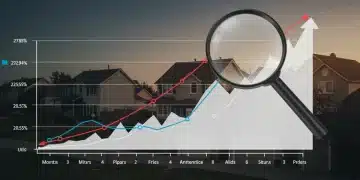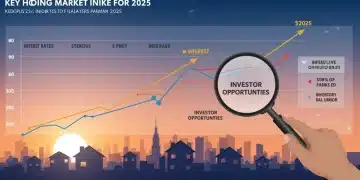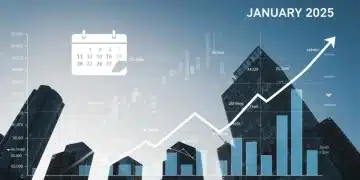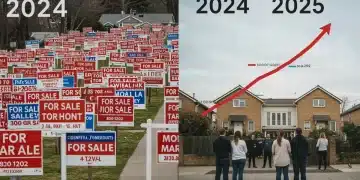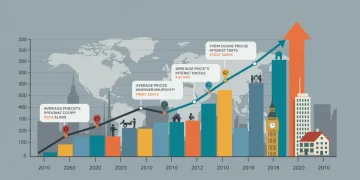The Current State of Rental Markets: Q1 2025 Analysis & Recent Updates

The rental market in Q1 2025 presents a dynamic picture with various regions experiencing divergent trends in rent prices and vacancy rates, driven by evolving economic conditions and demographic shifts.
Recent reports indicate that the current state of rental markets: a Q1 2025 analysis (recent updates) reveals a mixed bag of trends across major metropolitan areas and suburban locales, impacting millions of renters and landlords nationwide.
National Rent Price Fluctuations
As of early Q1 2025, national rent prices are demonstrating a nuanced pattern, with some areas experiencing continued growth while others show signs of stabilization or even slight declines. This divergence is largely attributed to localized economic conditions and varying supply-demand dynamics.
The overall national average for a one-bedroom apartment saw a modest increase of 0.8% month-over-month in January 2025, according to data released by Rent.com on February 10, 2025. This figure, however, masks significant regional disparities, making a blanket assessment challenging for those navigating the market.
Regional Price Divergence
Major coastal cities, particularly in the Northeast and West Coast, continue to report higher-than-average rental costs, though the pace of increase has slowed. Conversely, certain Sun Belt markets, which experienced rapid growth in previous years, are now seeing a deceleration, and in some cases, minor price corrections.
- Northeast: Cities like New York and Boston recorded marginal increases, with demand remaining robust despite high prices.
- West Coast: San Francisco and Los Angeles show stabilization, with some luxury segments experiencing decreased demand.
- Sun Belt: Markets such as Austin and Phoenix are adjusting, reflecting an increase in new construction supply.
- Midwest: Cities like Chicago and Detroit are observing steady, moderate growth, driven by job market stability.
These regional differences underscore the importance of local market analysis for both prospective tenants and property investors, as national averages can be misleading when making specific decisions.
Vacancy Rates and Supply Dynamics
Vacancy rates across the U.S. rental market in Q1 2025 are a critical indicator of supply and demand balance. Recent data points to a slight uptick in national vacancy rates, signaling a potential easing of market tightness that has characterized previous quarters. This shift is primarily driven by an increase in new housing completions.
According to the U.S. Census Bureau’s latest report on February 5, 2025, the national rental vacancy rate rose to 6.2% in Q4 2024, up from 5.8% the previous quarter. Analysts anticipate this trend to continue into Q1 2025 as a wave of new multi-family units hits the market, particularly in high-growth areas.
Impact of New Construction
The surge in new apartment construction, initiated during the pandemic-era boom, is now coming to fruition. This influx of supply is expected to alleviate some of the pressure on rent prices in certain highly competitive markets. Developers are delivering projects at an accelerated pace, responding to sustained demand over the past few years.
- Increased Inventory: Thousands of new units are becoming available, particularly in metropolitan areas that saw significant population growth.
- Developer Strategies: Some developers are offering incentives, such as one or two months of free rent, to attract tenants in newly completed buildings.
- Market Rebalancing: The new supply helps to rebalance the market, offering more choices to renters and potentially moderating price increases.
However, the impact of this new supply is not uniform. Construction delays and labor shortages in some regions mean that while national trends point to increased supply, local conditions can still vary significantly.
Economic Factors Influencing Rental Trends
Several underlying economic factors are significantly shaping the rental market in Q1 2025. Inflation, interest rates, and employment figures are all playing crucial roles in dictating affordability, demand, and investment decisions within the housing sector.
The Federal Reserve’s stance on interest rates, as outlined in their January 31, 2025, policy statement, continues to influence mortgage rates, which in turn impacts the decision between renting and buying. Higher mortgage rates often push potential homebuyers back into the rental pool, sustaining demand.
Inflation and Affordability Challenges
Persistent inflation, though showing signs of moderation, still impacts household budgets, making rent affordability a primary concern for many. Wage growth, while present, has not always kept pace with the cumulative increases in living expenses, including housing.
- Cost of Living: Rising costs for groceries, utilities, and transportation reduce the disposable income available for rent.
- Wage Stagnation: In some sectors, wage increases are insufficient to offset cumulative rent hikes from previous years.
- Budgetary Strain: Renters, especially those in lower and middle-income brackets, face increasing strain on their monthly budgets.
These affordability challenges are leading to shifts in renter behavior, with some seeking smaller units, moving to more affordable neighborhoods, or opting for roommate situations to manage costs.

Emerging Renter Demographics and Preferences
The demographic landscape of renters is continuously evolving, and Q1 2025 highlights several key shifts in preferences and living arrangements. These changes are impacting everything from apartment sizes and amenities to the types of communities being developed.
A recent report by the National Apartment Association (NAA), published February 7, 2025, indicates a growing preference among younger demographics for flexible lease terms and pet-friendly accommodations. This is prompting property managers and developers to adapt their offerings.
Gen Z and Millennial Influence
Gen Z and younger Millennials now constitute a significant portion of the rental market. Their preferences often differ from previous generations, favoring urban accessibility, technological integration, and a strong sense of community within their living spaces.
- Urban vs. Suburban: While some still prefer urban centers, there’s a notable trend of younger renters seeking suburban areas that offer a balance of affordability and amenities.
- Digital Amenities: High-speed internet, smart home technology, and integrated co-working spaces are increasingly non-negotiable for this demographic.
- Community Focus: Shared common areas, social events, and walkable neighborhoods are highly valued, fostering a sense of belonging.
These demographic shifts mean that properties that can cater to these evolving preferences are likely to see stronger demand and retention rates in the competitive Q1 2025 rental market.
Investment Outlook and Property Management Challenges
For investors and property managers, Q1 2025 presents a complex but potentially rewarding environment. While some of the explosive rent growth of previous years has moderated, the fundamental demand for rental housing remains strong, albeit with new challenges.
According to a market brief from CBRE dated February 15, 2025, institutional investors are carefully evaluating submarkets, focusing on areas with strong job growth and diversified economies to mitigate risks associated with oversupply in certain segments.
Operational Efficiencies and Technology Adoption
Property managers are increasingly leveraging technology to enhance operational efficiencies and tenant satisfaction. This includes everything from AI-powered leasing platforms to smart building management systems that optimize energy consumption and maintenance.
- Automated Leasing: Digital applications, virtual tours, and online lease signing streamline the rental process, benefiting both landlords and tenants.
- Predictive Maintenance: IoT sensors and data analytics help anticipate and address maintenance issues proactively, reducing costs and improving tenant experience.
- Tenant Portals: Online portals for rent payments, service requests, and communication are becoming standard, enhancing convenience and responsiveness.
Navigating the current market requires a strategic approach, blending traditional property management expertise with innovative technological solutions to maintain competitiveness and profitability.
Regulatory Changes and Tenant Protections
The regulatory landscape surrounding rental housing continues to evolve in Q1 2025, with several jurisdictions implementing new measures aimed at tenant protection and housing affordability. These changes can significantly impact landlords’ operational strategies and financial models.
As reported by the National Association of Realtors (NAR) on February 12, 2025, several states and municipalities are considering or have enacted new rent control policies, eviction moratoriums, or enhanced tenant rights, reflecting growing political attention to housing stability.
Impact of New Legislation
New regulations often introduce complexities for property owners, requiring adjustments to lease agreements, rent increase policies, and eviction procedures. Staying abreast of these local legislative changes is paramount for compliance and risk management.
- Rent Control: Some cities are exploring or expanding rent control measures, capping annual rent increases and limiting landlord flexibility.
- Eviction Protections: Stricter rules regarding eviction notices, just-cause eviction requirements, and legal aid for tenants are gaining traction.
- Affordability Mandates: New developments may face requirements to include a certain percentage of affordable housing units, impacting project feasibility.
These regulatory shifts underscore a broader societal push for more equitable housing markets, prompting landlords and investors to factor these considerations into their long-term planning and operational frameworks.
| Key Point | Brief Description |
|---|---|
| National Rent Trends | Overall modest increase (0.8% MoM) but significant regional divergences, with coastal cities slowing and Sun Belt adjusting. |
| Vacancy Rates | Slight national uptick to 6.2% in Q4 2024, driven by new construction, easing market tightness in some areas. |
| Economic Influences | Inflation and interest rates continue to impact affordability and the rent vs. buy decision, sustaining rental demand. |
| Demographic Shifts | Gen Z and Millennials drive demand for flexible leases, tech amenities, and community-focused living spaces. |
Frequently Asked Questions About Q1 2025 Rental Markets
While the national average shows a modest increase, significant price hikes are not uniformly expected. Regional variations are key, with some areas stabilizing or slightly decreasing, while others experience only marginal growth due to increased supply and economic adjustments.
Rising interest rates make homeownership less affordable by increasing mortgage costs. This often pushes potential buyers into the rental market, thereby sustaining demand for rental units and contributing to price stability or slight increases in some regions.
New construction, particularly of multi-family units, is increasing supply in many markets. This helps to alleviate pressure on rent prices and can lead to higher vacancy rates, offering renters more choices and potentially moderating cost increases in competitive areas.
The Sun Belt markets, which saw rapid growth previously, are now experiencing adjustments due to increased supply. Coastal cities continue to be expensive but with slower growth, while the Midwest generally shows steady, moderate rental increases influenced by local job markets.
Renters should prioritize local market research, comparing prices and availability in specific neighborhoods. Considering factors like lease flexibility, technological amenities, and community features, especially for younger demographics, can also lead to better housing matches and value.
Looking Ahead
The first quarter of 2025 sets the stage for a dynamic year in rental markets. Stakeholders should closely monitor evolving economic indicators, particularly inflation and interest rate policy, as these will continue to shape housing affordability and investment decisions. The ongoing delivery of new housing supply will be critical in balancing demand, while local regulatory shifts will introduce new compliance considerations for property owners. Adaptability and informed decision-making will be paramount for successfully navigating these emerging trends.
